The walls of Lynch’s Gym in South Bend, Indiana, are now lined with photographs of the old school wrestlers and even some obituaries of the dearly-departed grapplers. The gym’s owner and operator, Tom Lynch, started the gym 27 years ago after he decided to hang up his wrestling trunks after a 13-year career, primarily working preliminary and mid-card bouts for Dick the Bruiser and Wilbur Snyder in the Indianapolis territory.
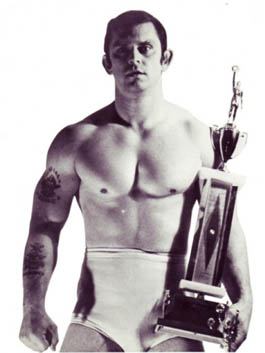
“Mr. Indiana” Tom Lynch in a posed publicity shot.
Lynch, whose real name is Thomas Lentych, got exposed to professional wrestling during his school days in the early 1950s.
“That would have been through the newspaper and seeing the ads when they used to put them in,” he recalled for SLAM! Wrestling. “I’d see the ads with Lou Thesz and Billy Goelz and Buddy Rogers for the Palais Royal in downtown South Bend on Wednesday nights. But that was a school night, so all I could do was either find somebody who went to the wrestling to fill me in, or I would wait until the next time they would come and I would see who is wrestling who.”
At Washington High School in South Bend, Lynch played football and baseball and got started in competitive sports.
“Back then, I was only 5’8″; but in those days, a kid six-feet tall was a giant. I enjoyed sports and back then, you played sports to be a better citizen; it wasn’t about winning all the time. As far as wrestling, we never had a wrestling team at my high school; only Central High School had a wrestling team. I never got interested in wrestling until after I graduated from high school. I did do a lot of working out with weights because I was a skinny kid and wanted to gain weight. It worked.”
His first exposure to a real-life professional wrestler was long-time veteran Doug Gilbert (Doug Lindzy), who was being trained by wrestler Johnny Gilbert.
“When (Doug) would come back to South Bend, he would drag me down to the YMCA and run out the big mat. I was his guinea pig for holds and counter holds,” laughed Lynch. “That’s where I learned professional wrestling holds and counter holds.” For a while, Doug Gilbert lived in South Bend and his friendship with Lynch continues to this day.
The next wrestling-connected individual Lynch met was Homer Miller of La Porte, Indiana, who built and set up the wrestling ring. “He’s the one that got me going to set the rings up ’cause this is one way you can get in and meet some of the guys and get acquainted with them. Plus we get to work out (in the ring) since the place is empty.”
Miller’s connections resulted in Lynch being part of the crew that set up the cage at one of the biggest cards of its day in the Midwest — August 14, 1970.
“When they had the very first cage bout at Comiskey Park in Chicago, Homer and I brought the cage and had to be there at the ballpark at 1:00 p.m. in the afternoon,” reminisced Lynch. “They had a lot of ringside seats. They gave us 15 minutes to get that cage up. We slid the cage to the ring as two sides were anchored to the ring posts, and the other sides had hooks where we swung it and bolted it down. It (the cage) was a hell of a thing to move around as it was long. We had to measure and make sure it was solid. The cage had one door to let them (wrestlers) in, and then we closed the door and put a lock on it. The only way to get out was climb over but that was a hell of a way up. Most cage bouts were no disqualification until they were down and out. Then they said open the door where they can walk out. When they (the combatants) said open the door, we would open the door. They (Bruiser and The Crusher) would start getting out but the Vachons (Mad Dog and Butcher) would grab them and pull them back in. It went on like that.”
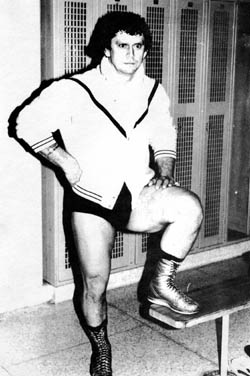
The first in-the-ring experience for Lentych, who eventually took the ring name Tom “Mr. Indiana” Lynch, came about as a result from his ring crew assignment.
“We took a workout after we got the ring set up in Elkhart. When we got done, Homer and I would go out and eat. And when we ate, we ate good. When we got back, Wilbur Snyder asked me if I had my gear.” Lynch got his gear from the ring truck to fill in for an AWOL grappler.
“I remembered that I just ate and asked when I would wrestle. He told me I would go on first against Big Bill Miller. Miller and I got talking and told me we’ll have a lot of fun — just relax, enjoy it, and listen to what I say Miller said. I drop kicked him and banged on him and did all kind of things. And it went good and he told me to do it again. I was having fun and enjoying it. I thought this is great. Then he got me in the airplane spin and thought, ‘Oh baby’ — it is coming out of my stomach. But he dropped me down and then pinned me and it was over.”
Snyder told Lynch to call Dick the Bruiser about the next step. Lynch called the following Monday in a ritual he would repeat countless times for next 13 years, from 1970 to 1983.
“The call-in at noon was every Monday to get your bookings. Sometimes you would have to sit on that phone, and you couldn’t call before noon. You would keep dialing and it would be busy, but finally you would get through. I would then ask, ‘Do you have any bookings?’ Then Bruiser would get his book out and tell you your dates,” explained Lynch. “He would never say whom you were against and would just tell you where you were at. He would tell you the towns and when the show would start. Sometimes I would ask where the venue was ’cause I had not been there. Back then I had a CB (Citizens Band) Radio in my car and then inquire how to get there.”
Lynch’s first planned booking for Bruiser and Snyder was for television.
“My very first TV was down in Indianapolis and they were taping at the Armory (North Side). Dick would put all the people on one side of the audience area to make it look like it was a packed house, and they had all the cameras on the other side. When he would tape, they would tape five or six shows. We would start around 6:00 p.m. and wouldn’t leave until 1:00 a.m. in the morning. When people would leave, Dick would put the (remaining) people more together.”
His final bout of the evening, against the boss, Dick the Bruiser, left a impression on Lynch. “That guy worked me over and wanted to find out what I could do or if I was worth it,” said Lynch. “When I came home at 2:00 a.m. in the morning, I had a big boot print across my chest — Dick the Bruiser’s boot print! My wife asked me if I was okay and what is that print on my chest. Bruiser climbs up on the ropes and comes down on you. I stay there still and boom — he puts his pressure on. He stands on you and you’re done. That to me was the start.”
Lynch began working the Indianapolis territory in other Indiana cites like Hammond, Elkhart, Fort Wayne, Muncie, Anderson, and Richmond, but it wasn’t a full-time job for the clean-cut babyface.
“I enjoyed being a babyface as I could walk down the street and be treated with hospitality,” said Lynch. “I worked for a beer distributor (Sunnyside) and my hours were flexible. There would be times when I would wrestle out of town, have to come back home to work the next day, and then leave early for the next card. I was raising a family with two small daughters but I managed. I liked the game. I didn’t care about drinking or carousing. I had a good understanding with the owner of the beer distributorship. The distributor’s insurance man was a personal friend with Dick and Wilbur. Most of my accounts understood my situation.”
Keeping kayfabe was sometimes a challenge in those old school days, especially in Lynch’s own hometown.
“The first time we were in Indianapolis at one of the TV stations (Channel 4) off a highway somewhere (Bluff Road). They had the ring against one wall, so you worked the sides where the people were sitting. They (The Blackjacks) threw me out and beat me with the chairs. Then you laid there and were taken out on a stretcher. The next weekend they showed that tape in South Bend. When I went to work on Monday (after that local broadcast), people asked, ‘When did I get out of the hospital?’ I said, ‘What do you mean, when did I get out of the hospital?’ I forgot about that (stretcher job) and then it dawned on me — ‘Oh, it wasn’t that bad.’. Fans said, ‘They beat you with that chair; you got any bruises?’ I said, ‘It worked out okay, but I had to go to the hospital as a precaution.’ I worked my way out of that one.”
The biggest payoff Lynch earned in those days was $210 for an appearance at the Fairgrounds Coliseum in Indianapolis around 1971. Lynch explained the system during his days with Dick and Wilbur.
“If you did TV taping, you didn’t get that much. Most of the people (fans) who came into that Armory got in free most of the time. He (Bruiser) wanted to get more people in there. You would usually wait afterward, and Snyder would be there with the big checkbook and he’d write checks. Now, the bigger the house there is, you got more money. They (Bruiser and Snyder) would take a percentage, depending on how many matches they had and how many wrestlers were involved. They would divvy up the money. They already had two to three guys on top besides Bruiser and Snyder. Nobody really knew who was being paid what. Sometimes we would ask Dick, if we were traveling 300-400 miles away, for transit money. Normally, he (Bruiser) would take care of you with the transit.”
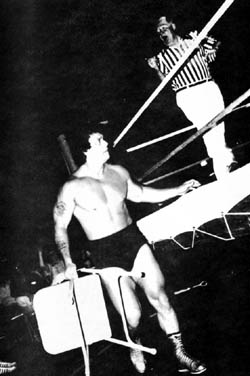
From time to time, Lynch got booked on a card in Michigan under the auspices of The Original Sheik (Ed Farhat) with Bruiser’s blessing.
“I would wrestle his card at Cobo Hall on Saturday night but would also wrestle Detroit television on that afternoon,” Lynch started, launching into a story about working with The Sheik. “I wrestled him on TV there and that was the time he put the big snake on me. He always carried that snake. He said, ‘Okay Tom, I am going to get that Camel (Clutch) on you, and I’ll be dueling and all that.’ He then flopped me down and went to his corner to get that snake out. He earlier asked me if I was afraid of snakes. I asked if this one bites. He said he didn’t think so. At the start of the match, he was in the ring already when I came in. He got the snake out and told me not to challenge the snake and to hop out of the ring. After winning the match, he got the snake out and let the snake crawl out over me. That was the first time I let a snake crawl over me and I never felt anything so cold in my entire life. The Sheik told me not to open my eyes and to lay knocked out.”
The decent relationship with both Dick the Bruiser and The Sheik sometimes presented a problem that Lynch had to work his way out of.
“Sometimes you would double book yourself on the same date when there’s an afternoon show and when there’s a night show. The afternoon show starts at 1:00 p.m. and the night show starts at 8:00 p.m. with a big time period in between. I was up in the Detroit area (afternoon show) and the matches were done. I figured I would take my shower and be on my way to Muncie for Bruiser’s card,” said Lynch.
Turns out The Sheik had other ideas. He said Lynch had to participate in the battle royale finale if he wanted to be paid. Lynch asked to be the first one tossed. “Then, I was, boom, the first one out. I got in the car and didn’t change clothes — kept by gear on. I just made it to the next town and got in by the armory. I was on the second match when I came in, Bruiser asked where have I been. I made it but decided that never again would I double book myself, unless the towns are 20-30 miles of each other.”
One of Lynch’s eventual co-workers in Bruiser’s territory was Chris Parsons, who worked as wrestler Mike DePree. Parsons remembered Lynch’s bout with the legendary Edouard Carpentier.
“The first time I recall seeing Tom Lynch was around 1969, when he did a TV bout with Edouard Carpentier,” Parsons said. “Now, this was a babyface bout, and a TV bout, so expectations weren’t too high, as ‘scientific’ bouts back then tended to run long in the tooth. This was an exception. Lynch wasn’t expected to do much, so when he dominated Edouard, you had to sit up and take notice. If I recall correctly, he even evaded Edouard’s body flip on the canvas. It looked like the bout was going the full 15 minutes, which in that time would have been an upset, when Carpentier cradled Lynch out of an arm bar and got the duke. Tom looked like a comer in this though, and wasn’t hurt by it.”
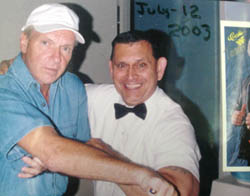
Lynch as a referee in 2003 with Bobby “The Brain” Heenan.
One time in a surprise situation, Lynch filled in as a referee in Hammond, Indiana, when the regular arbiter, Henry Van Loon, took ill. “He was going to (referee) the main event with Wilbur Snyder and his partner against The Valiant Brothers. The doctor was in there and would not let Henry come back out,” said Lynch. Van Loon’s blood pressure was deemed too high, and Snyder asked Lynch to fill in.
“I was wearing a tank top with USA on it. Wilbur asked me if I wanted to referee, and I told him I never refereed before. Wilbur said it ain’t nothing and it’s just like wrestling. He (Wilbur) said I can’t see nothing and I had to be blind. Wilbur said, ‘Just listen to us, and we’ll tell you when to turn your back and not see anything.’ I refereed and got through it. They (the good guy team) had their leg on the ropes, I was underneath, and I counted Wilbur out. The match was over and they (the crowd) were booing. I enjoyed it and Wilbur said it was good. Some fan said I didn’t think you were that blind. I thought that next time I went out, they (the crowd) would say something.
“I told Wilbur, ‘I think they hate me here.’ Wilbur said, ‘No, they’ll forget about it the next time we put you on the card.'” (In more recent years, Lynch would guest referee on local independent shows.)
Another challenge came that year at the Hammond Civic Center, where the ring never arrived. “They put one of those flat high school wrestling mats out there, and the ring never did come,” said Lynch. The wrestlers wrestled on that mat. “You talk about strange. They were on the same ground level as the people. Usually they like you to be above the crowd. Without any ropes, it was hard to do anything. The matches went pretty fast.”
As the 1980s moved along, the professional wrestling landscape in North America was starting to change with the growth of cable TV, the disintegration of the territories, and the national expansion of the WWF. Lynch, who was then in his early 40s, had sometimes talked with the old-time wrestlers about the signs that indicate you should retire.
“Al Costello said, ‘You’ll know, usually your legs give out first,’ and, ‘You start thinking more instead of doing,'” recalled Lynch, who saw it happening to himself.
“Before when they said you’re going to be thrown into the third row, you didn’t have to think about it and you let them throw you into the third row. Then all of sudden, you start thinking about it and say no, those people will move and I’ll hit those chairs. I may break my back. I may break my leg. You say no. I’ll get onto the third row on my own; you’re not throwing me. I got to where I climbed up onto the third rope standing with the (opponent) down below on the floor, where I would come down on him and give him a elbow to the head. When I looked down, it looked like I was at the top of a 10-story building. I thought if I jumped down there and if he moves or I slip, I may break a leg or an elbow. I knew then it is time to get out. I was getting that I didn’t want to do a lot of stuff.”
In late 1982, Dick the Bruiser began a short-lived partnership with Jerry Jarrett of the Memphis office and Lynch did not get any bookings at all. “Matches were getting far in between. Bookings would be once every two weeks, or maybe once a month. Things were changing,” Lynch said.
Today, Lynch looks back fondly at those years, especially his early years when he worked with some legendary old timers like Billy Goelz and Hans Schmidt.
“The oldtimers were masters and I was a beginner. This amazed me,” he admitted. “They took you and worked with you. They don’t want to show off how great they were; they wanted to make sure the fans had a good match. So they balanced it out with you. I had better matches with the oldtimers than actually working with the newer guys ’cause they only wanted to get ahead in the game.”
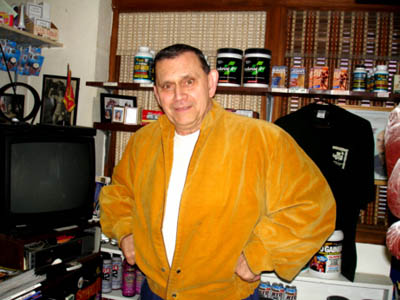
Tom at Lynch’s Gym in South Bend, Indiana.
Parsons only teamed with Lynch once on a Dick the Bruiser card, but has a lot of respect for him.
“I never talked with him at length, but at the same time, when I did talk to him he was like talking to someone I’d known for years,” said Parsons. “He was a very down to earth fellow. My impression of him was that he had figured out his place in the game and stuck with it. He worked a few nights a week for Bruiser or whomever, had a ‘real’ job, and had the best of both worlds. It’s my understanding he’s still married to the same woman, has raised his kids, and is still in great shape. To me, that’s a true measure of success.”
In the end, Lynch, who is now 71 years of age, has no regrets about his wrestling career. He was told by “The Boys” to enjoy the run, but also to do whatever the bosses told him — and he did. And for the last 50 years, Tom’s supporting partner has been his wife, Marty. She was happy to share a little tidbit about her husband. “He is very soft-hearted, and either one of his girls can bring him to years, even today. The girls — now grown with children of their own — say, ‘Daddy, I still love you so much, give me a hug.’ You will still see him melt. He has always had that tender touch. He is a real pussycat, will give you the shirt off his back, and will help anybody and everybody.”
